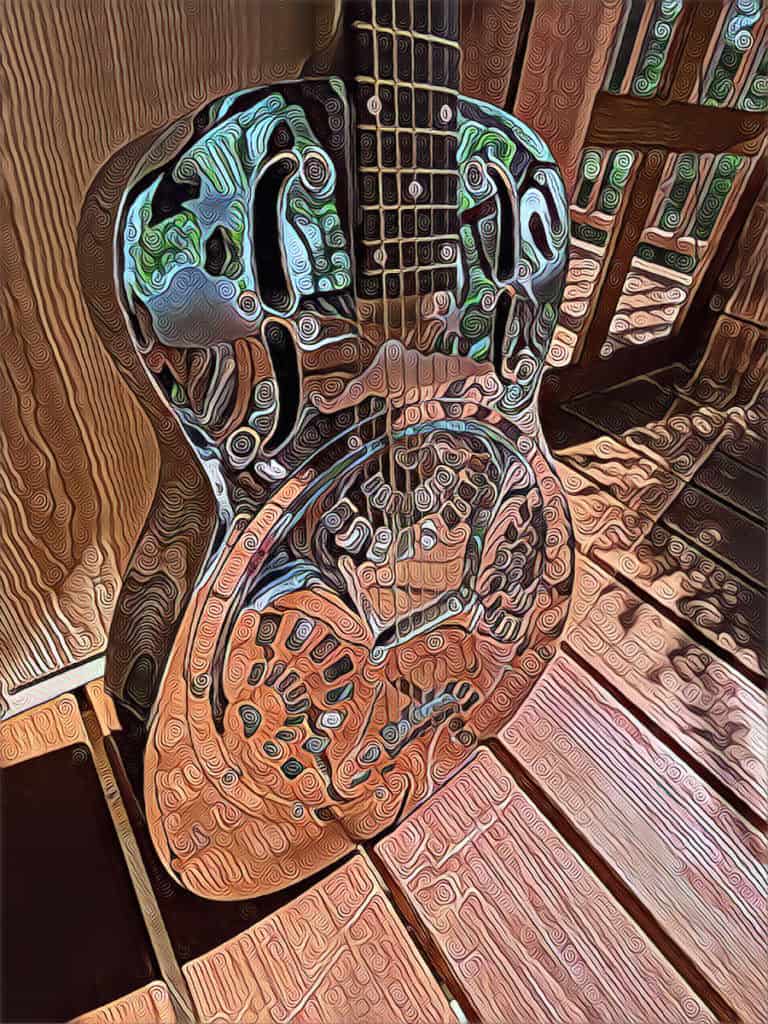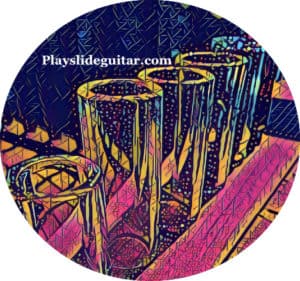As an Amazon Associate Playslideguitar.com earns from qualifying purchases. This page contains affiliate links.
When playing the blues, the feel and expression of the notes you play can be just as important as the notes themselves. This is why the distinct and versatile sounds that slides can make are great for playing blues on guitar.
The vocal-like qualities of slide guitar, such as the vibrato and phrasing, are great for creating a genuine and evocative sound that listeners can relate to.
By taking a look into playing the blues with a slide, you can learn ways to further your playing and creativity on guitar for blues songs…
Slide Guitar and The Blues Tradition
Before we dive deeper into the art of playing blues with a slide, it helps to understand the intriguing history of the blues and slide guitar.
Ironically, using a slide on guitar played a pivotal role in blues music as a whole. Many people are unaware that without the slide, it is likely that blues music and traditions would have evolved a lot differently.
The ability for a slide to create a projecting tone, along with its expressive capabilities, helped guitarists in the earlier part of the 1900s make their sound cut through a mix of instruments.
This helped in the notion of a guitar being played for more than just its rhythmic qualities, and further developed the idea of using a guitar as a melodic and lead instrument that is capable of creating solos and melodic ideas.
Delta Blues Slide Guitar: Bottleneck Playing
Before amplifiers were invented and widely used, and when guitar was still known for playing mostly rhythm and chords, the louder and distinct sound that a slide made on strings was attractive to some guitar players from a playing standpoint. The slide provided an easy way for a guitarist to quickly play melodic ideas on a single string, without having to learn complicated techniques, fingerings, and scales.
As slide guitar became more widely known, especially in the bottleneck blues tradition, many blues players gravitated towards the technique and often used open tunings.
The interplay between a player’s chords, lower-pitched strings (for bass notes), and vocal melodies, allowed the use of a slide to create even more call and response patterns to add interest for listeners. This is why many great bottleneck blues players from the past were able to entertain listeners by playing solo: their rhythm, chords, melodies, and slide riffs helped create enough texture and sound to delight listeners.

If there’s one thing that slide guitar proved within the history of blues music more than anything, it’s that the guitar can be used very effectively as a melodic instrument capable of producing riffs, solos, leads, and interesting melodic motifs.
It is quite possible that the blues guitar playing we love so much from B.B. King and many others, which is full of exciting riffs and phrasings, would be a lot less prominent (and much different) if it weren’t for slide guitar. Slide guitar, especially in blues music, opened up many avenues of expression for guitar as an instrument itself.
Check out Woody Mann’s Bottleneck Blues Guitar (link to Amazon), which is full of tabs, history, and playing advice, and is a great book about this style of music.
Regardless of history, slide guitar has an appealing and captivating sound that fits well with many styles of music, especially the blues. Let’s explore using a slide for blues playing, and learn some techniques and ideas that can be used when creating music.
Learning How To Play Slide Guitar Blues
More likely than not, it is the playing techniques of slide guitar that deter some players from utilizing it in their guitar playing, despite most players being drawn to the sound it makes. However, players interested in slide guitar can benefit greatly from the realization that the techniques of slide guitar aren’t as challenging as many believe.
Remember that many early blues guitar players actually picked up slide guitar because the technique was easier for them to utilize for melodic playing, compared with the dexterity and agility required for fretting notes with the fingers.
Moving Up The Neck: Playing Notes That Are Higher In Pitch
One of the most effective ways to play blues slide guitar is to utilize the higher register notes that are often located either higher up on the fretboard, or on the higher pitched strings (often string numbers 1 and 2).
This technique allows the notes to project and cut through a mix of sounds, which is especially important for developing riffs, melodic ideas, and solos. Playing higher up the neck, or on higher-pitched strings, was a technique used in the early days of blues slide guitar playing.

When playing the blues with a slide (especially with a band that has bass, drums, and other instruments), it is important for the guitar’s timbre to spark interest and reach the listeners without compromising the sounds of the other instruments. These higher notes can be a great way to do this naturally.
How To Accentuate and Phrase Notes: Slides and Vibrato
Since blues playing is so emotive, especially with slide guitar, finding a way to play notes with feeling and expression is often a matter of finding creative ways to slide into notes. Furthermore, the use of vibrato to accentuate the sustain of notes is another great way to create emotion within a blues song.
There are many ways to slide into a single note, depending on the speed and timing of the slide, as well as the distance of the slide. The way you slide into each note will also affect its phrasing and articulation, which plays a big part in the “voice” of that note. Even more pivotal however, is the vibrato that is applied to notes as they are sustained.

By shaking or rolling the slide back and forth over a note, the pitch can be altered very slightly at different rates to produce accentuation at the tail end of the note as it sustains and rings out.
Trying different types of vibrato, and energizing the tail end of notes with it, is a great way to create more interesting slide blues licks and solos.
To create an even bluesier effect on certain notes that you want to emphasize, experiment with longer slide distances into notes, as well as exaggerated vibratos. Although these may sound too drastic in many musical situations, they can give you ideas on how the slide can be used within a solo to create emotion and energy that a listener can really connect with.
Singing The Blues
A great way to improve your slide blues playing, and improve your intonation, is to sing phrases that you hear in your head over any blues song and try to emulate them on a single string on the guitar.
Listen for any subtle nuances your voice makes as you sing such as inflections, vibrato, dynamics, and percussive elements. It is most likely that your slide will be able to create the same accentuation of notes, and this is one of the most direct ways to understand the advantage of using a slide to voice notes on guitar instead of just the fingers.
Even just singing one note, and emphasizing it in different ways with your voice, is a great way to learn how to replicate these sounds with your slide. If you can find several ways to create interest through the expression of a single note, then you’ll have more creative options for your playing.
Slide Guitar Blues Artists
There have been many great slide guitar blues artists in history, and many talented players continue to carry on the tradition in new and innovative ways. Many guitar players in blues history helped pioneer the sound of slide within the genre.
Delta Blues Slide Guitarists
Since slide guitar has such a strong foundation in the bottleneck playing of Delta blues, taking a look at some of these guitarists is a great way to learn more about playing slide guitar blues. Robert Johnson is perhaps the most well-known figure from this tradition, however the list of great slide players is much more extensive.
Here’s a list of some Delta blues slide guitarists that have contributed greatly to the sound and tradition of blues slide guitar:
- Son House
- Tampa Red
- Charley Patton
- Robert Johnson
- Leadbelly
- Muddy Waters
- Mississippi Fred McDowell
- Blind Willie Johnson
- Sylvester Weaver
- Barbecue Bob
- Blind Joe Reynolds
- Earl Hooker
- Snoozer Quinn
- Elmore James
- Booker White
- Bukka White
- Oscar Woods
- Ramblin’ Thomas
- King Solomon Hill
- Robert Nighthawk
- Blind Willie McTell
- Reverend Edward Claiborn
- Blind Boy Fuller
- Bo Weavil Jackson
By listening to recordings of these players, you can gain a lot of ideas and insights into playing the blues with a slide. Many of these players were great at combining vocal, rhythmic, and melodic ideas within a song, and they were often great solo performers as well.
More than anything, they played with a lot of feeling and emotion, and connected with listeners regardless of their technique. These were some of the best slide guitar blues artists, and their ability to develop phrasings and motifs with the slide shows just how much you can add to a song with simple slide melodies and riffs.
Modern Slide Guitar Players
In modern music, it is interesting that the guitar has found an incredibly strong presence all over the world as a lead instrument capable of producing riffs, solos, chords, and other elements.
But what is even more intriguing is that so few guitar players utilize the advantages of using a slide to make these sounds (considering how pivotal the slide likely was in creating them).
However, slide guitar continues to grow in music, and many modern players have found fresh and interesting ways to use it in their music.
Derek Trucks
Having become one of the most well-known slide players and guitarists of all-time, Derek Trucks has one of the most distinguishable and expressive slide voices in history. His ability to span genres, while staying rooted in the blues traditions of the technique, have made his playing versatile and unique.
Trucks has taken the techniques of playing slide to a new level, discovering ways to create sounds and ideas that aren’t possible using just your fingers to fret notes. Using primarily an Open E tuning, he has also shown how versatile an open tuning can be for slide guitar playing.
Take a listen to this live album he recorded with the Derek Trucks Band, to hear just how innovative his playing is…
Warren Haynes
Warren Haynes, who plays in similar musical settings as Trucks, is another great modern slide player who continues to contribute a lot to the slide guitar blues genre. His approach to guitar is often rooted in blues and rock, especially with his band Gov’t Mule, and his slide playing can quickly evoke a sound that catches the attention of listeners.
He’ll often play slide guitar in standard tuning, which is a great way to jump right into playing the blues on slide guitar. If you’re already from a guitar background, and don’t want to spend the extra time learning a new open tuning, it can be a quick way to begin learning slide playing techniques.
Check out Haynes’ Guide to Slide Guitar (link to Amazon), which is a great book for discovering more about his playing approach and mindset towards slide guitar.
More Modern Players Worth Checking Out
There are many other slide guitar players that are contributing greatly to slide blues in modern music. Here are some artists that are great to listen to for playing ideas and techniques…
- Joe Bonamassa
- Jason Isbell
- Tim Reynolds
- Sonny Landreth
- Keb’ Mo’
- Dan Auerbach
- Luther Dickenson
- Harry Manx
- Ben Harper
Players like Jason Isbell, Dan Auerbach, and Ben Harper have found neat ways to add them to recordings in the studio, adding a more expressive sound to certain elements of songs.
Furthermore, for artists who use blues music in a modern context, the slide can be a great way to add more texture and musical tradition to their songs. Check out Tim Reynolds’ work with some of Dave Matthews Band’s blues-oriented songs, and Luther Dickenson’s approach to playing with the North Mississippi Allstars.
Blues Slide Guitar Songs
There are many traditional and modern blues songs that utilize the slide guitar, and they can be great for learning more about slide guitar styles and techniques.
Players like Duane Allman and Ry Cooder have played great versions of “Statesboro Blues,” and Duane’s playing on this tune on At Fillmore East has inspired many guitar players to begin playing slide guitar.
More traditional tunes like “Stagger Lee”, “You Got To Reap What You Sow”, and even “Amazing Grace” can lend themselves well to blues slide guitar.
Also, it can be beneficial for your slide playing to explore blues tunes that are based in the jazz genre. Since so much of jazz music stems from blues harmony with variations, playing slide on jazz blues tunes can be worthwhile. “All Blues” by Miles Davis is a great song to play the blues on, and the tune lends itself well to the voice and techniques of slide guitar.
Slide Guitar Blues Tuning
Open tunings are commonly used by many blues slide guitarists because the tunings are great for playing chords without having to use your fingers to fret notes. Also, many open tunings have become a part of the slide guitar blues tradition, and can be great for playing without a band.
However, you can use standard E tuning (that most guitarists play) and have just as much versatility for playing the blues. Although standard E tuning may not be able to produce as many full sounding chords with the slide, it can be great for soloing or riffs, and players are often already familiar with the tuning.
Here are some common types of tuning that work well for playing the blues with a slide:
- Open E Tuning
- Open D Tuning
- Open A Tuning
- Standard E Tuning
- Open G Tuning (which can also be the same as a Dobro’s tuning)
Exploring some of these open tunings can be a great way to learn more about why they’re used for slide guitar blues. Often in an open tuning, the 6th and 4th strings are the same pitch, which can be great for creating a steady bass line with your thumb as you use the slide to play melodically on the higher pitched strings.
Take a look at what tuning some of your favorite slide guitarists use when they play the blues, and see how they utilize it in their playing. Often you’ll be able to notice certain areas or pockets of the fretboard that they use more frequently, and see how they voice chords at certain positions using the slide.
Conclusion
Blues music is a remarkable form of musical expression for any instrument, and the slide guitar is a great way to dive deeper into the genre. Since slide guitar played such a pivotal role in earlier blues music, its tradition fits well with the genre and can be a great way for new or seasoned players to further develop their slide guitar playing.
For more playing tips and technique advice, click here…
